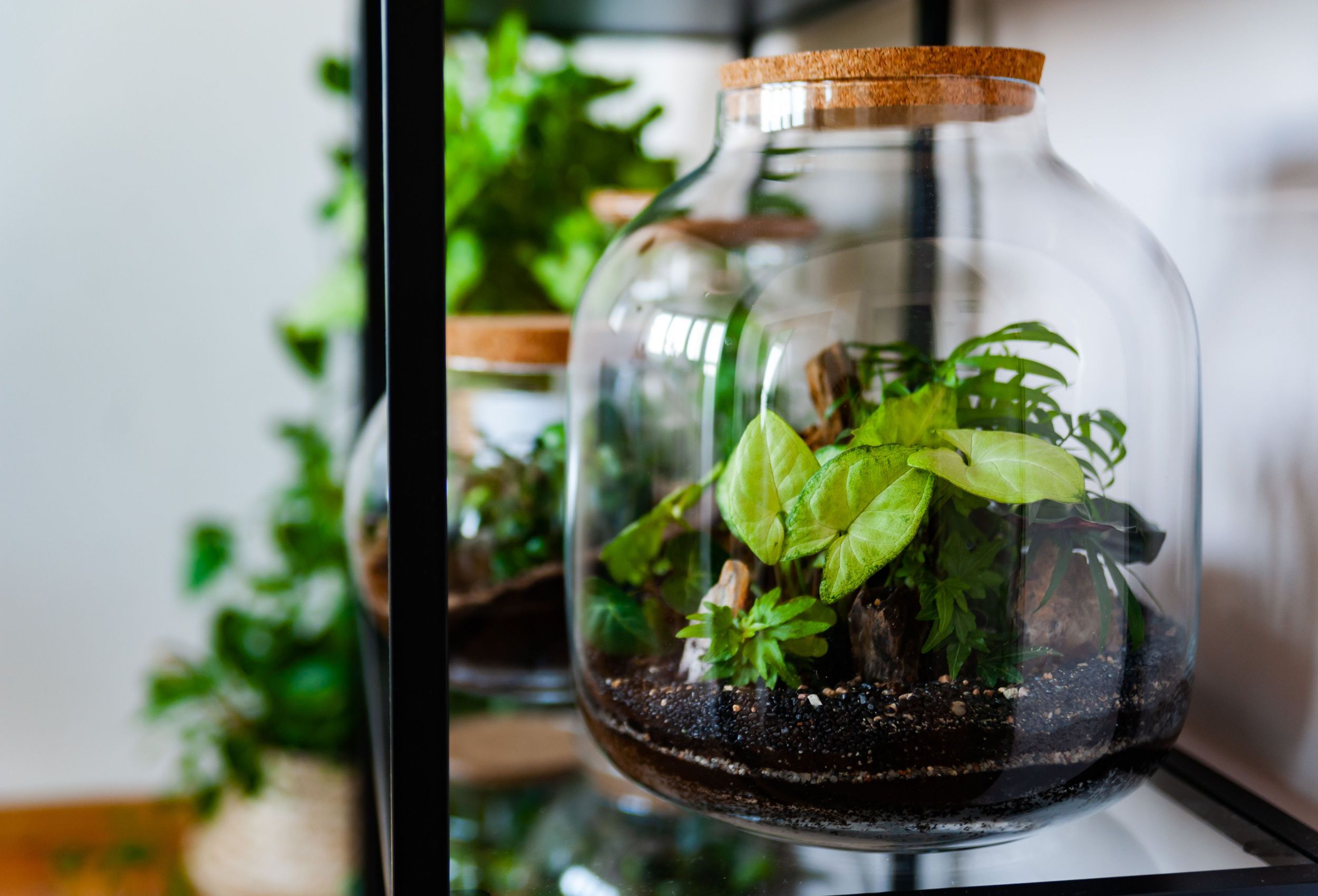A closed terrarium is an intriguing, mini ecosystem with self-sustaining qualities. They require little to no intervention to thrive and can continue growing for years.
However, to ensure that your closed terrarium develops and prospers, you must pay due diligence to the plants you select. Plants that love warm, moist, and humid environments will easily survive in a sealed container. Additionally, you'll want to consider petite varieties or slow-growing plants to reduce the need for pruning and shaping.
Take a look at the nine best plants that can thrive in a closed terrarium.
1. Peace Lily
Peace lilies are popular houseplants that can also be a part of your closed terrarium. The tropical natives can easily survive in a high-humidity environment and dappled sunlight.
While most household varieties can grow as tall as 16 inches, opt for a smaller plant species, such as 'Petite,' which is approximately 8 to 10 inches in height.
2. Nerve Plant
Nerve plants are an intriguing addition to any terrarium. They have mottled, deep green leaves with striking silvery veins, which can be the highlight of your mini ecosystem. The plants remain relatively small once fully grown, so they easily fit inside most containers. They are also partial to humid weather and indirect, bright light.
3. Polka Dot Plant
Incorporate vibrant hues into your terrarium with the flashy polka dot plant. The delicate plant has stunning dark green foliage covered with pink spots and grows best in bright light. You can also find hybrid varieties with splashes of red, white, or light green spots. The 'Confett' series grow about 8 inches high, making them ideal for a terrarium.
4. African Violets
African violets are charming plants, flaunting brilliant clusters of blue, purple, or white flowers on a backdrop of dark green, fuzzy leaves. The vivid blooms love humid conditions, making them perfect for inducing color in your terrarium. While the plant has numerous varieties, the 'Miniature' one is best suited for a terrarium as it is less than 8 inches across.
Place your terrarium with African violets in indirect sunlight, as direct sunlight can lead to excessive humidity and condensation.
5. Lemon Button Fern
Another plant to elevate the allure of your miniature garden is the lemon button fern. The fern has tiny, rounded leaflets on cascading fronds and is small enough to fit inside a terrarium. It also loves above-average humidity levels and is generally unfussy. Keep your fern in indirect sunlight for the best results.
6. Maidenhair Fern
Another great fern to introduce textural interest in your terrarium is the maidenhair fern. The delicate fern has smooth, dark stalks laden with clusters of bright green fronds. It grows best in moist places, and dry surroundings can turn its fronds brown. Hence, the closed-off ecosystem brimming with humid air is perfect for this fern.
The fern prefers indirect bright light from a north-facing window. You can also keep it a short distance away from an east- or west-facing window.
7. Earth Star
Named after its distinguished shape, Earth star has stiff, strap-shaped leaves with wavy edges and attractive variations. The 'Pink Starlight' comes with olive green leaves, striped with deep pink. The plant is a bromeliad, but unlike many of its family members, it prefers rich soil and high humidity.
The distinct plant is partial to bright filtered light. Watering bromeliad is quite different from most houseplants. To water your bromeliad, fill the cup or reservoir in the center of the leaves and replace this water weekly to protect the plant from disease and root rot. Use filtered water, rainwater, or melted snow, since tap water can contain chemicals harmful to the plant.
8. Spike Moss
Spike moss is a common houseplant and a charming addition to your terrarium. It has decorative, mossy foliage that fans out and survives successfully in the warm, humid terrarium environment. The moss prefers semi-shade since bright light will scorch its leaves.
9. English Ivy
Another way to fill the space with lush foliage is by adding English ivy. The versatile plant provides an evergreen background to other terrarium plants. The 'Congesta' cultivar is a dwarf, non-climbing shrub with small, lobed leaves and an ultimate height of around 4 inches.
Place your ivy near a north- or east-facing window or under filtered light from a southern or western window.
Nurture Your Closed Terrarium
With a closed terrarium, you only need to water it occasionally. To determine the moisture levels inside the terrarium, check for condensation in your container.
There should be condensation on the inside of your container as it will run down to the soil, thus creating its own water cycle. If you notice condensation on the plants, it indicates a high moisture level. In this case, remove the lid from your terrarium each day until everything is dry (this could take anywhere between 15 minutes to one hour).
On the other hand, if you notice the condensation on the container drying up, add small amounts of liquid to the soil but stop immediately once any excess starts puddling up rather than sinking in!
Use distilled or dechlorinated water to avoid tipping the bacterial balance and burning the roots. Water sparingly using a syringe, dropper, or a small scoop and tilt the container for even distribution.
Terrific Terrarium Plants
A successful terrarium is teeming with striking moisture-loving plants that grow together to create a sustainable ecosystem. Therefore, choose your plants according to their growing requirements, and of course, for your target aesthetics.
Have you ever grown a terrarium? Share your experience and any questions below in the comments.

